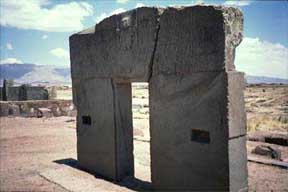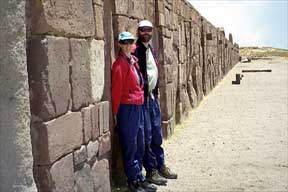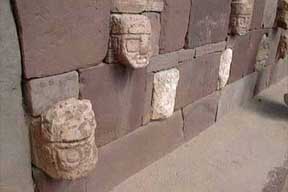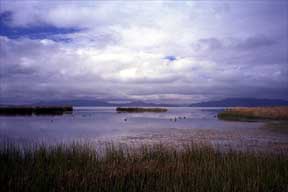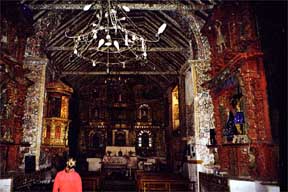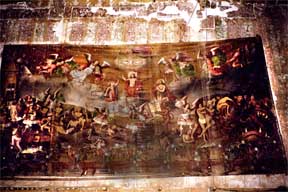| Activities
and Events surrounding Lake Titicaca |
| |
|
| Day
2 |
| SouthWind Quote |
|
| |
Following breakfast,
we'll depart for a 65-mile drive across the highlands heading toward the
southern end of Lake Titicaca, the highest navigable lake in the
world at 12,505'. Backdropped by the towering pyramidal peaks of Huayna
Potosi (19,975') and Condoriri (18,557'), we'll enjoy expansive views of
the Altiplano, or high plain, as we drive along dirt roads to visit
the ruins of the pre-Incan ceremonial center of Tiahuanaco. En route
we'll stop at the typical highland town of Tambillo and visit their ancient
cathedral which was built in the 15th century. Then we'll continue to Koani
Pampa where the Tiahuanacan culture developed the largest potato growing
center in the Andes using a technique called Suka Kollo, or a system
of cultivating plants in raised beds surrounded by water channels to moderate
the freezing nighttime temperatures of this high elevation. Next, we'll
join our guide for a walking tour of the main center which was built from
some of the most imposing megaliths found among the pre-Columbian cultures
of South America. Our visit will include the square, ritual-platform compound
of the Kalasasaya, the 52-foot high Acapana pyramid, the 45-ton Gate of
the Sun whose surface is adorned with carvings of celestial bodies which
may indicate that it was used as a calendar to predict solstices and equinoxes,
and the Puma Punku site where several other massive stone slabs (some weighing
up to 120 tons!) have been unearthed. Afterwards, we'll drive back to the
main road and head northwest to the fishing town of Huatajata, located
on the southeastern shores of the lake. Here in the afternoon, we'll visit
the San Pablo Museum which has been moved from Suriqui Island. We'll spend
the night at the Titicaca Hotel (or similar) overlooking the lake. Total
driving time: 4 hours (CB,L,D) |
| Lonely Planet quote |
| |
Traditionally regarded as the highest navigable body of water in the
world (in reality there are higher lakes in Chile and Peru), Lake Titicaca
is immense: its dimensions measure 233km (145mi) from northwest to southeast
and 97km (60mi) from northeast to southwest. The lake has an indented
shoreline, 36 islands and exceptionally clear sapphire-blue water. Titicaca
is revered by the Indians who live on its shores, and the Islas del Sol
and Islas de la Luna, two islands in the lake, are the legendary sites
of the Inca's creation myths.
|
| |
Reseach on Islands
of the Sun and the Moon by
Chip Standish Ph.D., Dept. of Anthropology, U. of Chicago, 1985
|
| |
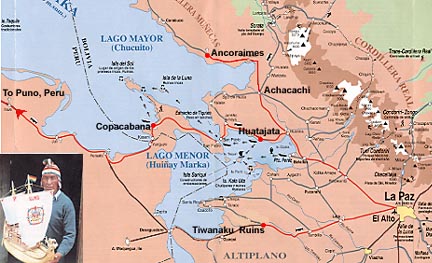
We traveled on the roads marked by red lines
|
|
|
| |
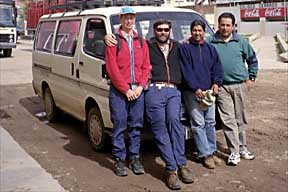
|
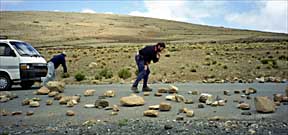
William the guide and Santiago the driver were the best!
|
| |
Tiahuanaco
Ruins |
| |
The historical ceremonial center of Tiahuanaco, 70km (43mi) west of the
city, which is Bolivia's most important archaeological site.
Located 72 km (44 miles) west of La Paz, Tiahuanaco sits in a long, desolate
wind-swept valley that today barely provides a poverty level subsistence
for its inhabitants. But 2,000 years ago it is believed that this valley
was one great agricultural area and via an immense system of Sukakollu
(raised fields) fed the equivalent of all of Bolivia today and allowed
for surpluses, freeing up part of the population to feed huge armies.
It is thought that Tiahuanaco was a great imperial capital of an immense
empire that stretched from Ecuador to northern Chile.
|
|
| |
From Bolivia, Footprints Handbook: "The ancient
city of Tiahuanaco must have been an impressive sight to visitors with its
skyline dominated by great pyramids, temples and palaces. The two largest
edifices, the Kalasasaya Temple and the Akapana Pyramid, were 200 m long
and over 20 m high. They were constructed from massive blocks of andesite
weighing more than 150 tons that were ferried on reed boats from quarries
across Lake Titicaca. The exterior of the buildings was decorated with intricately-carved
stone friezes and bas-relief work, much of it covered with thin plates of
gold or painted in hues of blue, red, gold and black. The overall effect
must have been dazzling." |
|
| |
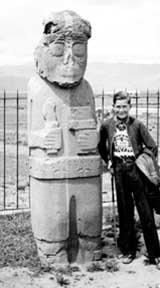
Nelson Beck at Tiahuanaco Ruins 1937.
|
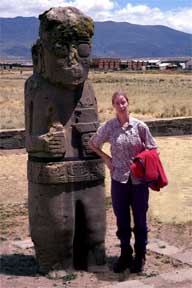
Bindy Beck-Meyer at at Tiahuanaco Ruins 2000. |
|
|
| |
According to the latest carbon 14 test, this former
capital of a highly advanced nation dates back to 1580 B.C. This Aymara
civilization developed through five periods and at the peak of its splendor
(around 700 A.D.) covered an area of 232,558 sq. miles, and was the largest
city in the world, with more than 100,000 inhabitants. The Tihuanaco artisans
worked the mysterious monoliths that characterize these ruins, several of
them in granite and obsidian. You will visit the ruins of Akapana Pyramid,
the Kalasasaya and underground temples, aqueducts and the famous Sun Gate,
which is carved with symmetrical figures. The structure of the physical
remains indicates that its social consideration reached one of the highest
levels of development, and for this reason Tiwanacu is considered to be
the "Cradle of the American Civilization". |
| |
|
| |
|
|
| |
|
|
| |
|
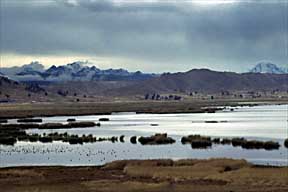 |
| |
|
|
| |
Lake
Titicaca |
| |
QUICK FACTS: (Gathered from a variety of places and not verified)
- About half the lake resides in Peru and half in Bolivia It is the
highest navigable body of water at 3,821 (11,463 feet) meters
- It covers 8,300 square km, sunning 190 km NW to SE & is 80 km across
- It lies in a 60,000 square km basin between the coastal & eastern
Andes
- The average depth is over 100 m with deepest point at 281 m
- 25 rivers, mostly from Peru, flow into the lake and a small outlet
leaves the lake at Desaguadero on the Bolivia-Peru border, which is
only 5% of the inflow with the rest lost in evaporation.
- The lake is the remnant of a vast area of water formed in the Ice
Age known as Lake Bolivian
- The traditional totora-reed boats take 3 days to build and last 7-8
months while wooden boats take longer to build but last 7-8 years
- If someone falls into the lake, like a fisherman, it is traditional
not to rescue them but to let them drown as an offering to the Earth
Goddess Pachamama
|
| |
|
|
| |
Huatajata |
| |
You drive on a paved road running parallel to
the impressive Royal Range of the Andes, Huatajata is an oasis of modern
facilities on the still primitive Bolivian high-plateau. The harbor overlooks
the lake and is surrounded by native mud, adobe brick homes. In Huatajata
you find some of the pre-Columbian reed boats, you get to see the proud
llamas and alpacas and you can discover a lot of the most unique Lake Titicaca
Culture. |
| |
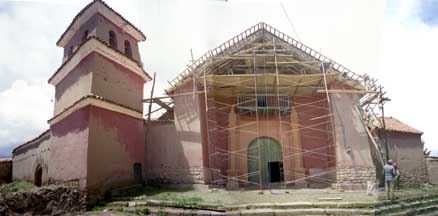
Church under restoration in Carabuco.
Church was built in the 1500s and still shows signs of using candles
to illuminate the textiles that were hanging on the walls. |
| |
|
|
| |
|




